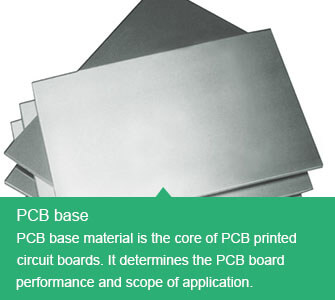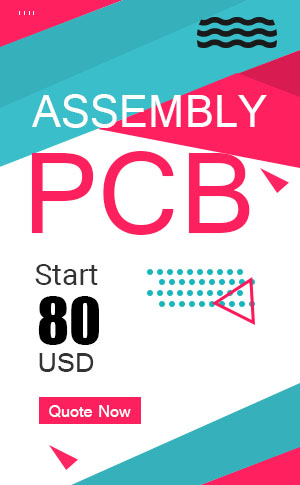General, quoting & support.
Add: Building E, No.58, Nanchang Road, Xixiang , Baoan District Shenzhen City, Guangdong, China
Tel : 0755-27348887
Fax : 0755-27349876
E-mail : svc@pcbastore.com
What PCB materials are widely used and How?
Simon / 2021-09-11
Contents [hide]
The performance and durability of your PCB board are dependent on the PCB board material. But when it comes to selecting the right board materials, it's crucial to review the different materials available for various categories. Let's delve deeper into the world of PCB materials to know the best bet for you.
Basic Components of Standard PCB
Printed circuit boards or PCBs are generally flat-laminated composites manufactured from non-conductive substrate items with sheaths of copper circuit work. They range from simple single or double-layered designs to high-density materials containing even more than 50 layers. There are six fundamental components of a standard PCB which includes:
Prepreg
This is a thin glass fabric that comes layered with resin and then dried in specific equipment known as prepreg treaters. This glass fabric works as the mechanical layer holding the resin in its right position while the resin which is generally, polyimide, Teflon, FR4 Epoxy or others begins in liquid form which is layered over the fabric. When it moves inside the treater, it finally reaches a well-heated oven where it starts drying up.
Next, the prepreg is melted at a temperature above 300 degrees F where it hits the thermosetting point. As this happens, the resin starts becoming solid once again and gains a lot of strength. Prepreg sheet is an important PCB material that helps in gluing it together and building the next component, that's laminate.
Laminate
Often referred to as copper clad laminates, these are made of prepreg and sheets. It is laminated together in the presence of pressure as well as heat and loaded with copper foils on both sides. With the hardening procedure done, PCB laminates appear to be similar to a plastic composite.
Copper foil
Copper foil is another significant PCB material that is used for producing the circuits over laminated surfaces. These circuits later become the electric wiring or conductors both on the internal as well as the external parts of the board.
Solder mask
Solder mask refers to the green epoxy layer covering the outward coating of the board. Since the internal circuits remain well protected in the prepreg, they don't require any protection. On the other hand, the outer layers will oxidize as well as corrode when left unprotected. The work of solder mask is to offer that protection to the conductors placed on the outer part of the PCB.
Nomenclature
Nomenclature refers to the lettering that's visible on the top part of the soldermask that layers the PCB material. It is used for showing where each component goes on the PCB and sometimes gives insight into the orientation of the component.
Final Finish
Both nomenclature and solder mask are also manufactured in shades other than white and green. But these two colors remain the most popular. It is also important to shield the copper holes which mostly remain exposed. Metallic coatings like gold, tin, nickel, silver, and other finishes are used for protecting all the vulnerable areas of the PCB board material.
Brief Introduction for PCB Material
The substrate along with the laminate makes up the fundamental electrical, thermal, and mechanical circuit board properties. The foundation of the circuit, which is also called the base contains two main parts: laminate and the substrate.
Substrates
Substrates are generally dielectric composite structure which contains paper and epoxy resin or unwoven glass weave. They are supplemented ceramic for increasing the dielectric constant. They are also used for catering to some property requirements like Tg or glass transition temperature at which the materials start to soften or deform due to heat.
There are broad variations of standardized substrates which allow the fabrication of PCBs. Polyimide, RF 35, Alumina, and other flexible substrates. The most commonly implemented substrate is FR-4.
Laminates
Laminates are constructed under viable pressure and comprise layers of paper or cloth along with thermoset resin. Quite as it goes with substrates, you can also customize laminates to meet the properties and requirements. Some of the most important properties of laminates are shear and tensile strength, CTE, Tg, and the coefficient of thermal expansion.
Most Popular Materials Used in PCB Fabrication
Some of the most effective materials considered in the process of PCB fabrication include:
FR4 Epoxy Laminate and Prepreg
These materials come with good electrical, thermal, and mechanical traits which make them the most popular choice in most of electronic applications. It goes well with PCB that has low layer counts.
Polyimide Laminates and Prepreg
It is best suited for high-temperature performance compared to FR4 substances and as a result, costs more. It maintains stability during thermal cycling with less expansion characteristics.
Teflon Laminates and Bonding Plies
These materials offer a remarkable range of electrical properties which makes them suitable for high-speed circuit applications. Teflon laminates can also be layered on glass fabric or used with specialized additives or fillers for improving mechanical properties.
Flexible Laminates
These materials are quite thin structurally and offer the ability to manipulate the design without affecting the electrical continuity. They are very effective even when folded into the device for a single flex when installing an application.
Others
Alongside, there are other bonding and laminating materials such as ceramic, cyanate ester, BT, and blended systems.
How to Select the Best PCB Material for your Design
The choice of PCB material must meet the design requirements, the quality of production and cost need to achieve a balance. The design requirements include electrical and institutional parts. This material problem is usually important when designing very high speed PCB boards (frequencies greater than GHz). For example, the commonly used FR-4 material may not be used when dielectric loss at several GHz frequencies, which can have a significant effect on signal attenuation . In the case of electrical, it is important to note whether the dielectric constant and the dielectric loss are combined at the designed frequency.
There are several physical characteristics and properties that can be helpful when choosing the best PCB material. These traits also play a significant role in a comprehensive substrate and laminate analysis. Some of the most important factors to consider are:
Thermal performance: For elevated service environment
Dielectric constant: Determines the electrical performance
Mitigated loss factors: For all high-speed applications
Flame retardance: Important for UL qualifications
Mechanical strength: Includes tensile, shear, along with other crucial mechanical considerations which may be needed as the PCB is given to servicing
Dimensional ability: Consistency and frequency of the movement of materials during various procedures
Classifications of PCB Materials
PCB base material is the core of printed circuit boards. It determines the PCB board performance and scope of application. Different products have different requirements on the PCB base material. With the development of electronic technology, PCB base material meet more and more challenges, which also push the development of copper clad laminate(CCL).

Classification of Copper Clad Laminate
There are five different types of material divided by reinforcing material : paper base, glass fiber cloth base, composite base (CEM series), laminated multilayer board base and special material base (ceramic, metal core base, etc.).
Paper base class:PF resin (XPC, FR1, FR2) Epoxy resin (FE-3) Polyester resin
Glass fiber cloth base class:Epoxy resin (FR4, FR5)
Special material base class:BT, PI, PPO, MS
Classification of Flammability
Flame-proof type: UL94-VO, UL94-V1
Non-flameproof type: UL-94-HB
Classification of CCL Performance
CCL with ordinary performance
CCL with low dielectric constant
CCL with high heat resistance
CCL with low coefficient of thermal expansion
Conclusion
PCB is one of the most crucial factors of electronics and as they play an important role in everything right from calculators to computers, PCB material selection should be done with care by considering the necessities of the particular equipment.
PCBASTORE will help you to analyze and choose the most proper materials to help you get high quality electronics PCB for your products at the lowest cost. If you have any comments or suggestions about this post, please leave a reply here.
Previous article:What Inspection Methods are often used in PCB Aseembly







